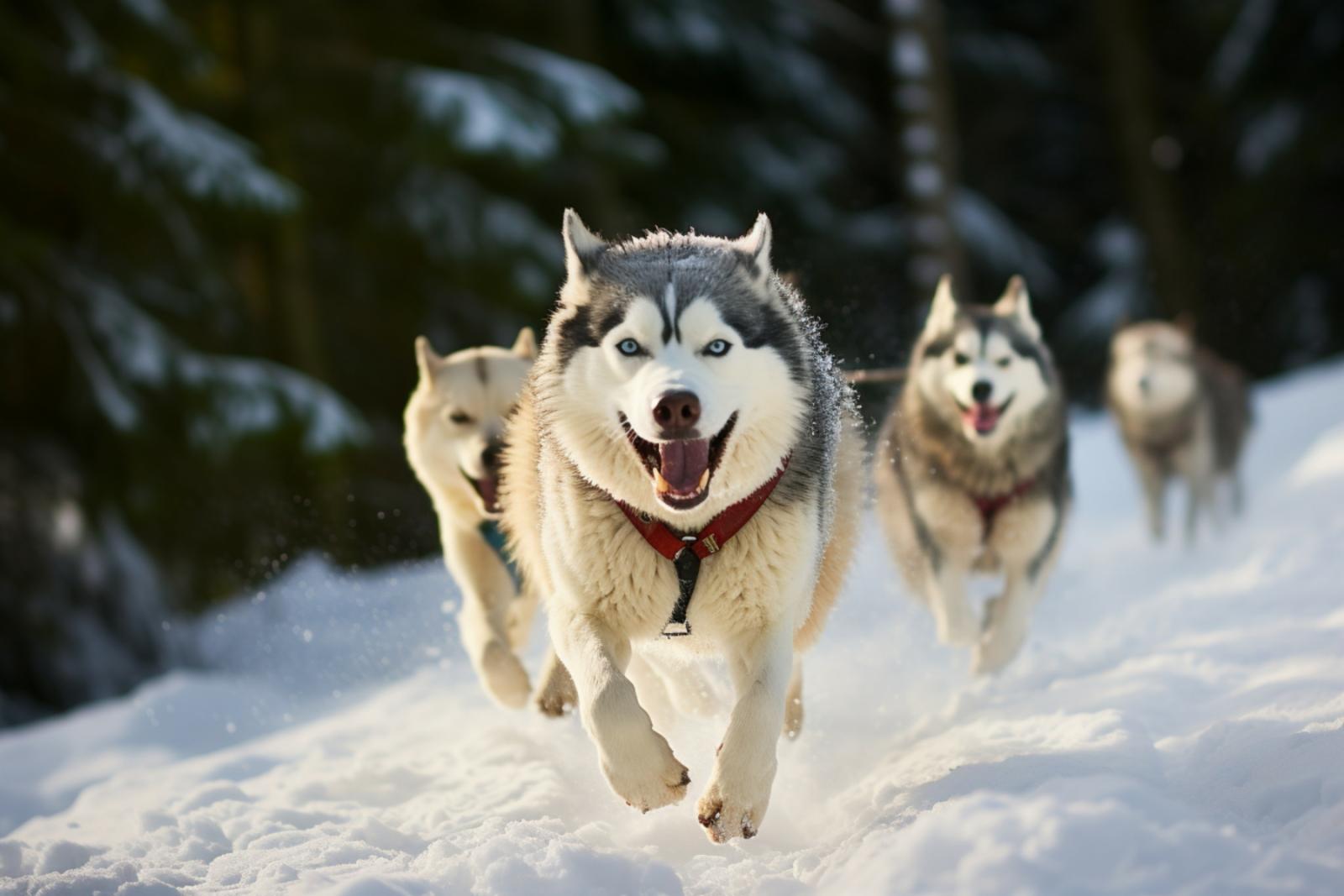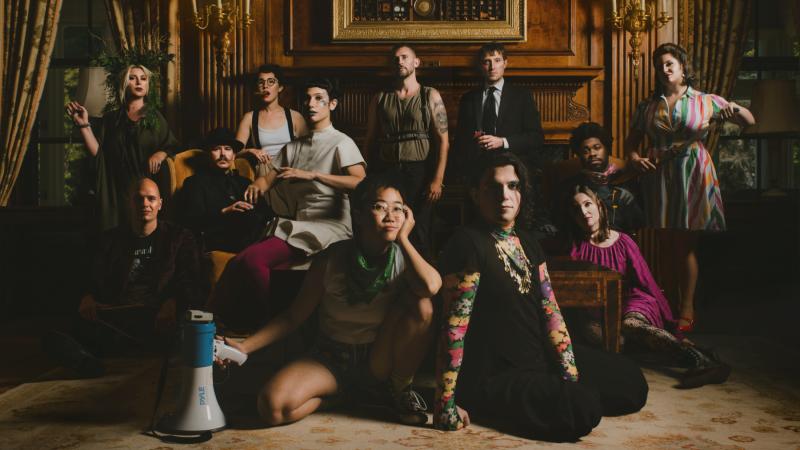Kate Newmyer ’94 has a fondness for adventure, cold weather, and travel, all of which brought her to Alaska's Denali National Park on a 2018 family vacation. Midway through the trip, the Lawrence University alumna crossed paths with another of her favorite things—dogs. In this case, sled dogs in training.
“They were sweet and cute in the yard, but when the harnesses came out, a switch flipped and those dogs wanted to run,” Newmyer said. “You could see the joy and purpose emanating from them.”
Her curiosity was piqued.

Kate Newmyer '94 visits with a sled dog named Ukulele.
A year later, Newmyer would hear an NPR interview (via Wisconsin Public Radio) with Blair Braverman, a Wisconsin-based musher, adventurer, and writer who was preparing for the start of the 2019 Iditarod Trail Sled Dog Race, the most famous of sled dog races. She listened as Braverman spoke of the training, discipline, hardships, endurance, and perseverance all wrapped into nearly 1,100 miles of remote Alaskan terrain.
“My hair stood on end,” Newmyer said.
Her curiosity turned to passion, and the Iditarod quickly became a focal point for this art historian-turned-elementary school teacher as she taught fifth graders in Clear Lake, Texas, southeast of Houston, more than 4,000 miles from the Anchorage-to-Nome Iditarod trail. She began infusing stories, vocabulary, and images from the Iditarod into her classroom wherever and whenever she could—from reading and writing to daily lessons in perseverance.
Four years later, Iditarod organizers would take notice. Newmyer, who studied classics and art history at Lawrence and earned a Master’s in art history at the University of Oregon, found herself with a new, albeit temporary, title midway through 2023. She was named the 2024 Iditarod Teacher on the Trail™, a year-long designation that carries with it responsibilities to be an education ambassador for the Iditarod, the sled dogs, and the mushing life. She writes lesson plans and other education materials that teachers across the country can incorporate into their classrooms. And she will spend a month in Alaska before and during the early March race, giving talks to students and teachers, visiting with mushers, and experiencing various Iditarod-related events in and around Anchorage.
“Then after the race starts on March 2, I’ll be flying out to stay in some of the remote checkpoints of the interior so I can share education ideas related to how the race is unfolding on a daily basis,” Newmyer said. “I will infuse the values of the Iditarod and what it represents—preserving Indigenous cultures, awareness of nature, a generous and lively mushing community, and, of course, athletic competition based in large part on how well you provide care for your dog team.”
Newmyer will be in Nome for the finish of the race, expected to be roughly 10 to 12 days after it begins in Anchorage.
‘A winding road’
Newmyer’s deep dive into the musher life is the latest detour in a lively, unpredictable journey since she walked across Lawrence’s Commencement stage in June of 1994.
“It’s been a winding road, in true Lawrence fashion,” she said. “Lawrence really prepared me for anything.”
That road took her to Oregon for graduate school and then to the Portland Art Museum, where she worked as a registrar.
After getting married, Newmyer moved to rural Colorado in 2003, where she leaned into the music training she got at Lawrence; she became a secondary music teacher. When the family would later move to the greater Houston area, she shifted gears again, going to work as a fifth-grade teacher.
“Part of our reading curriculum until recently was Greek and Latin roots, so that was fun getting to use classical languages again,” Newmyer said.
Connecting with students
She found the Iditarod—the dogs, the outdoors, the adventure—to be a fun way to connect with her students even though it was seemingly a world away from southeast Texas. As an example, she began presenting a classroom honor known as the Red Lantern Award. In the Iditarod, it is given to the last musher to finish, symbolizing perseverance. In her classroom, it goes to a student overcoming obstacles.
“Students vote on a student they deem worthy, and they really take it seriously,” Newmyer said of her classroom version of the Red Lantern Award. “I want my students to see they can have agency over their lives as these mushers do; they can persevere, they can make a choice to live their dream.”

Sled dogs show up in all corners of Kate Newmyer's classroom.
She said she has found joy in weaving the Iditarod into almost all aspects of her teaching.
“The Iditarod isn’t just one unit but infused into everything,” she said. “For example, I have Iditarod books for independent reading time, and I include Iditarod articles, poetry, and other texts in my teaching resources. I create Iditarod sentences and resources to use for revising and editing. I use Iditarod analogies for everything—the writing process, ‘mandatory gear’ for learning activities, and trail checkpoints for major assignments.”
Taking a leap of faith
Newmyer had to apply for the Iditarod Teacher on the Trail™ role.
“These teachers were like celebrities to me,” Newmyer said. “I saw a photo of a teacher in a Cessna 2-seater flying over the Alaska bush with a sled dog, and I thought, I want to do that.”
As one of three finalists, she was invited to Alaska for the 2023 Iditarod, and went through a series of interviews and challenges, and she was asked to present at the 2023 Iditarod Education Winter Conference.
“I met the mushers and attended the start of the race,” she said. “While I was there, I had to create a blog post every day with ideas for how you could teach any content through the Iditarod lens. All aspects of my character and teaching skills were being evaluated.”
A few weeks after returning home, Newmyer got word she was selected as the 2024 Iditarod representative. Her work began in July 2023 and continues through June 2024.
“In addition to my lesson plans—which have to appeal to a broad range of teachers, students, and homeschool families—I am writing a post each month sharing ideas for classroom culture, where teachers can use the Iditarod to build cohesion, share camaraderie, and have fun with their students,” she said.
Lessons from Lawrence
Newmyer points to her Lawrence experience as key to navigating career changes and her many detours into areas of passion. It’s the love for a liberal arts education that has shined every step of the way, she said. It eventually brought her back to the classroom.
“When I first came to Lawrence, I had to pinch myself because I could literally study anything I wanted," Newmyer said. "I tried all kinds of subjects I never thought I could do, which helped me know myself—what I was fascinated with, what I felt I could contribute to. Lawrence gave me confidence to try new things, to work at them, and to share their importance with others through writing and speaking. So, when it came time to make career decisions over the years, I drew on my time at Lawrence to have confidence that I could take on any challenge and learn anything new.”
Those lessons, she said, are front and center in her year-long Iditarod adventure.
“I want to bring people into the deeper meaning of what the Iditarod represents and the values it exemplifies—inclusivity, care for and partnership with animals, healthy competition, a love of the outdoors, respect for tradition, problem-solving, a balance of self-reliance and teamwork—the list goes on,” Newmyer said. “Lawrence provided the foundation for me to be able to research, notice, and think critically, then to effectively pass on my ideas in an engaging way.”




